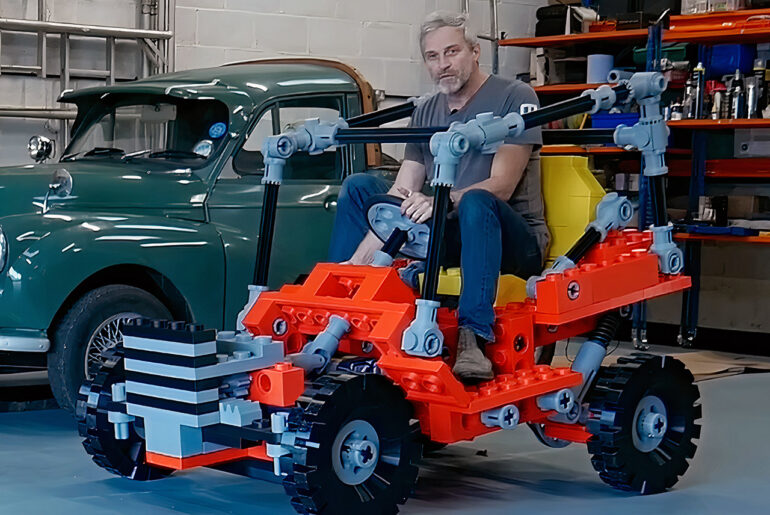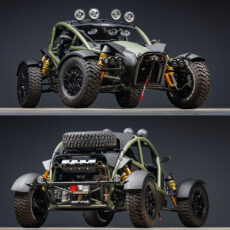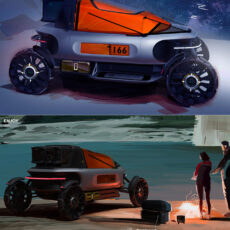
Matt Denton, a legend when it comes to transforming tiny models into full-size sit-ins, has spent years making the unthinkable a reality. His new creation, a monstrous version of the 1981 LEGO Technic Dune Buggy (8845), is no exception. What began as a simple kit of 174 plastic parts has been expanded to accommodate a large adult behind the wheel.
The original 8845 Dune Buggy of the time was a true head-turner, with rack-and-pinion steering and swing-arm suspension packed into a two-seater frame. Denton retained the magic but made it more driver-friendly by repositioning the steering wheel to the center and freeing up a seat in the previous cargo compartment, which is now a really excellent place to sit. Taking the initial concept and scaling it up to 10.42 times its original size was not an easy task. In fact, Denton states that this was his most difficult test ever, necessitating numerous last-minute printouts and late-night tinkering sessions.
- High-Speed Precision: Experience unparalleled speed and precision with the Bambu Lab A1 Mini 3D Printer. With an impressive acceleration of 10,000...
- Multi-Color Printing with AMS lite: Unlock your creativity with vibrant and multi-colored 3D prints. The Bambu Lab A1 Mini 3D printers make...
- Full-Auto Calibration: Say goodbye to manual calibration hassles. The A1 Mini 3D printer takes care of all the calibration processes automatically,...
Denton took all of it and reconfigured it for the driver, moving the steering wheel and cleaning away the cargo space to make room for a comfortable seat. He then scaled everything up to match typical 50-millimeter axle bearings, which had the added benefit of making the entire device roughly the size of a go-kart. As with any LEGO build, beams and panels were constructed to mimic the studded appearance of actual LEGO bricks, but this time they were designed to support the weight of a grown adult.

Every curve and joint on this object was first designed in CAD software to ensure that everything fits properly and that the print lasts. It was also where he decided to separate the huge plates to stay inside the restrictions of his 3D printer, as well as include enough of bracing to keep the thing from twisting under stress when driving.

Printing was the foundation of this project, with Denton churning large continuous pieces of PLA filament on a 3D printer belt-style equipment. He chose a 1 millimeter nozzle, two layers of outer wall print, and a sparse 10% infill to make the completed product as light as feasible while maintaining snap-together strength. The filament he used was a durable red variant of PLA called Polysynic, which handled the demands of this job admirably, if you don’t consider the multiple power outages, blockages, and print bed warping. Denton spent around 1,600 hours running the printer on this project, not all of which went smoothly. Smaller bits were produced on secondary machines, and any that failed were melted down and reprinted; it was not a simple operation, to say the least. Finally, the printer generated a skeleton weighing 102kg, which feels very robust but yet flexes somewhat – as is to be expected when working with layers of plastic.
Building the frame was a bit like solving a massive jigsaw puzzle, one piece at a time. Denton’s starting point was the chassis, and he got to work putting heated bearings into some special slots to help the whole thing pivot smoothly before adding the front arms, which swing freely on either side. The steering rack is actually all one piece, molded like a block of bricks, and it’s got a pinion gear and a wheel wrapped up in some heavily-gripping rubber to really help the thing corner.

The rear arms swing together via a big steel tube that’s been hammered in place – it’s a trade-off between flexibility and rigidity, and the aim is to keep the back end as stable as possible. Denton also made sure to seal any seams that needed it, bolted on bits that could get torn in a crash, and even came up with a special jig to drill holes in the right places without messing up his prints. The wheels had thrust washers to help cut down on drag, and the struts themselves had limit blocks to stop them bottoming out too hard.

Suspension was a total trial-and-error situation. Denton started out with coil springs that were rated at about 3kg/mm compression, but they were compressing way too much under the weight of the buggy and him inside it, and the whole thing would sag when he got in. The travel was only 56mm, which wasn’t enough for the combined weight of the vehicle and driver (162kg) – so he had to swap them out for something stiffer. He even went so far as to double up some of the springs for a while, but eventually settled on a single, beefier spring that he’d shifted back to get some extra leverage. There’s a special block in place to make sure the struts move in a smooth, even way, and don’t get any sudden unexpected drops in force.

The tires – each one a whopping 4.6kg of TPU wrapped around a PLA core – are the final bit of contact with the ground. Denton printed them in quadrants to stop them bridging, and added some lips and keyways to make them easy to snap together without needing glue. The wheels get held in place with some self-tapping screws and a pattern of drilled holes, while the hubs are clamped down with captive nuts for easy swapping. The fronts handle steering input from the swing arms, while the rears connect to a belt drive that sends power from the motor – which is a pretty simple setup at the moment – just a solid axle that sends torque straight to the wheels.

The motor is just a single ODrive type 8325 affair, and it’s bolted on at the back. It’s connected to a steel pulley on the axle via an HTD5 belt. Denton had to cut up some adapters to get everything to fit together properly, and then got in the basics – an 80-amp fuse, a toggle switch to turn the power on or off, a toggle switch for the direction of rotation, and some sim-racing pedals to give him some decent throttle and brake control. The braking’s a bit of a hack – just the motor’s regenerative draw routed through a resistor bank on a heatsink – two 500-watt units in parallel to give him about 1.5-ohm drag. The algorithm’s supposed to be able to fine-tune the reaction to get some more performance out of it – but as it stands things, he’s having some problems: the belts slip a bit under load, and the engine can’t quite get the buggy moving at walking speed. He knocked up a quick hack to let one side’s keyway come loose so it can pull a single wheel, which helps in the corners a bit, but the thing still leans heavily to the left. He’s routed the control cables under the frame, and the control box itself fits onto some printed brackets that look suspiciously like LEGO bricks.
[Source]










